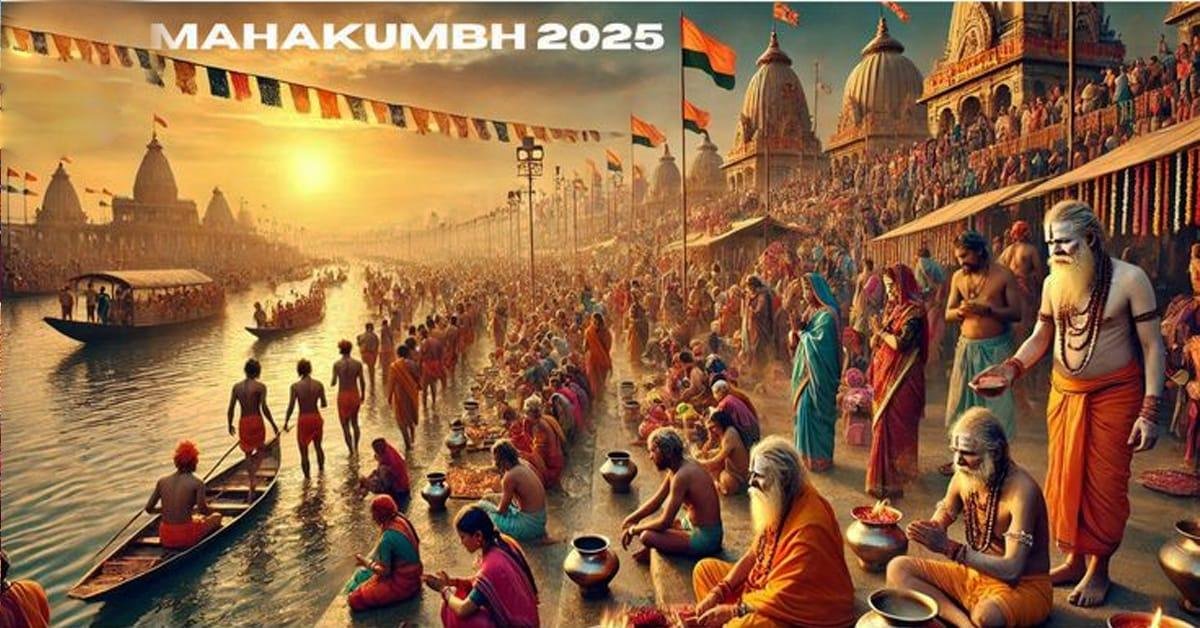Portugal sent a priest to convert Akbar Jahangir and gave 700 bighas of land to the arena; Naga Sadhus chased away Timur
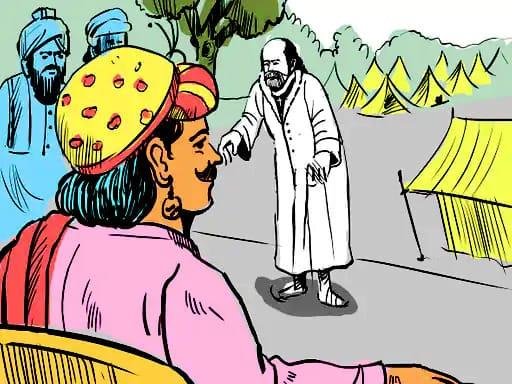
Afghan ruler Ahmed Khan Bangas had captured Delhi and Awadh and moved towards Prayagraj. According to the official document related to Jhansi Jhansi Gavjat, in 1751 he captured the fort of Allahabad. At that time Kumbh was going on on the banks of Sangam. As soon as the news of Bangas’ attack reached all the Naga Sadhus, they took the front in their hands. Many Nagar Sadhus reached there under the leadership of Rajendra Giri Mahant and fought with the ruler Ahmed Shah who was Mangal Savdhan and forced him to return. The historian faced the attack of the Mughals. According to BBC, in the first episode of the series of Maha Kumbh, the story of Kumbh in medieval India from Harshvardhan to Aurangzeb.
Akshay Bhai Tirtharaj was present in Prayagraj Sangam. It is the same Akshay Pat that Mughal ruler Jahangir tried to cut but failed. According to the documents of the state archives of Prayagraj, Jahangir had then said that this Vat tree is proof that Hinduism will never die. Ahmed Alberuni, a contemporary historian of Mahmud Ghazni. has written in his book Tarikh al-Hind that around 1017 AD, Brahmins and Akshat used to commit suicide by climbing this tree. It is said that this Banyan tree was blessed by Mother Sita at the time of the deluge when the whole earth was submerged, even then this Akshay Banyan tree will remain present. After building the fort in 1583, Akbar also imprisoned Akshay Bhatt inside the fort and banned darshan. After 36 years, in 2019, it was again opened to the general public. There is no exact proof of when this gathering of saints and devotees started at the confluence of Ganga, Yamuna, and Saraswati. At the beginning of the seventh century, a Chinese traveler reached Prayag with King Harshvardhan of North India. That person used to be called Vincent Pragya Polo in the Chinese language. That person writes that Harshvardhan stayed here for 74 days. He kept donating food, clothes, etc. every day. The money earned for 5 years was looted at his place. When Harshvardhan’s entire treasury became empty, he finally donated his crown as well and smilingly said that it was well done. Whatever I had, it entered such a treasure where it can neither be destroyed nor can you spend it in holy works. According to this, during Kumbh, hundreds of Kalpasis used to give up eating and drinking so that they could die at this holy place. In the eighth century, Vedic saint Kumari Bhatt died on this land. During this time Shankaracharya also came here. In the year 1567, Akbar came to Prayag for the first time for two days. He thought why not build a fort at this beautiful place? According to this, Akbar used to call Prajna Piya. In the year 1575, when he came to Prayag again, he built a huge fort and named Prajna Allahabad. the place where God lives. Akbar was very impressed with Kumbh. During Kumbh, when Akbar was in Allahabad, Banda Di, who was a conversion expert, reached Prayag and started plotting to convert Akbar to Christianity. However, Akbar fled from his intention and did not convert. According to historian Haram Chaturvedi’s book Kumbh Itihasik Van, during the Mughal period, the debate between saints in Prayag started during the reign of Shahjahan’s elder son Dara Shikoh. After peeling the cart with coins, he got the rate done and till the end, he donated a lot to the temples. Later on he also started collecting taxes. In the Mughal period you come across that there was a proper officer who used to depend on the river and collect tax. Once when Aurangzeb fell sick, he requested Ganga water to drink. He considered Ganga water to be the water of paradise.
Stories of Maha Kumbh-2
People used to offer their first child to Ganga: The British used to levy tax on cutting beard and hair; Ganga water was sent to London in a silver urn
was the year 1924 when Ardh Kumbh was organized in Prayag. The British government had banned bathing in the Sangam due to the distraction, but one decision of Nehru ruined the entire plan of the British. In the second episode of this series of Maha Kumbh, the story of Kumbh during the British period is told.
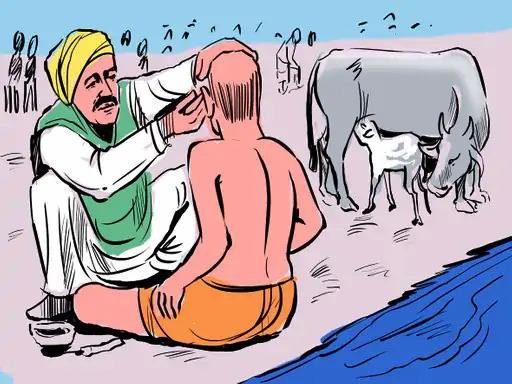
Historians say that angry with this order of the British, Madan Mohan Malviya sat on a dharna near the Sangam. Malvi ji was Malvi ji and he said that bathing in the Sangam is not necessary. He is a great friend. Yesterday, for the video, he started Jal Satyagraha. Nehru ji said that early in the morning, I also felt that he was doing something and I should also go. He went and stood behind the barricade. He mentioned it in his autobiography and said that when he could not bear the heat, he took a dip in the Ganga. Nehru ji, nobody used a stick on the barricade. No tear gas was released. No one arrested him because it was the municipality and seeing him, so many people took a bath and through the police, Nehru ji said that he did not want to take the bath. He came out and directly took a dip in the Sangam. This is how the order of the British was. A story related to the British kept on flowing. On February 1, 1888, in the British newspaper Maksane Masihi, there was news about the Kumbh going on in Prayag. At the confluence of Ganga and Yamuna, a British officer is getting the route of a procession of 400 Naga Sadhus cleared. This is sad and shameful. Instead of punishing for nudity, the government is supporting the Hindus. After this news, questions were raised in Britain as to why the government deployed a British officer for this work. This is a matter of shame for the Christian religion. What should the British officer write? He should answer that this is a matter of his faith. Whenever he takes out a bath, he does not trouble the common citizens. He goes on his way. People touch his feet with devotion. We have not seen any immorality in this yet. And the Tirthankar imposed a tax. In the year 1801, ₹1 tax was taken from the pilgrims coming here. A report was made on the Kumbh Mela, according to which, during the Kumbh, thousands of rupees were collected from those who cut hair, new gardeners, milk, cows and calves, hawkers, and drivers. The amount of tax collected is that of the Health Dispensary Public Library of Allahabad. You can see that the entire expenses of that library were met by advertising to prevent looting at the fair and to warn people not to give shelter to any unknown person in their camp. Tax hospitals were built in Kumbh in 1918 because 207 people had died before this and 167 due to pneumonia. During British rule, one had to pass a proper exam for duty in Kumbh. Officers were called from England for Kumbh management. During Kumbh in 1918, the saints and sages were facing many difficulties in drinking water. Then Bada Panchayat and Nirmal Akhara, without permission, made water supply overnight. When the British officers came to know about this, they got the cans closed and arranged for water in the Sangam area. In the third episode of which series of Maha Kumbh, the story of the freedom movement and the Kumbh connection is told.
Stories of Maha Kumbh-3
745 Nagas sacrificed their lives for Lakshmibai: The British hanged the Pandas; Trains and buses were stopped due to fear of rebellion, it was said that Japan would drop bombs
The rebellion from Meerut against the British in 1857 reached Allahabad. On June 6, Maulvi Liaquat Ali liberated Allahabad and the surrounding areas. Still, then Karnal Neel, who came with the British army, caused great destruction here, destroyed the images of saints, and took over all the parts of Sangam. In 1857, the Mang Mela could not be held here. Still, the next year of the rebellion, i.e. in 1858, the Jamaat fair was held, then the entire Sangam area was burning in the fire of revolution and rebellion. If you see the flags that were on the target, their form has changed, so we are beginning to see the revolutionary thoughts of this kind. Flags took the front in which 745 Naga Sadhus were killed. In the third episode of the series, the story of the freedom movement and Kumbh connection During the revolution of 1857, revolutionaries were roaming in Prayag under the influence of saints and sages. During this time, Rani Lakshmibai also went to Prayag. Maharani Lakshmi Bai also came here. Proof of this It is said that she stayed at a Pandey’s place in Daraganj and that was the time of the beginning of the war of 1857. When the British got the news of this, Rani Lakshmibai returned to Gwalior, although the British were leading the British army chasing her there too. Meanwhile, a bloody conflict took place between Rani Lakshmibai and the British soldiers. Vrindavan Lal Verma writes in his book Lakshmi Bai the Queen of Jhansi that the queen had a deep wound in the lower part of her chest. There was a lot of blood flowing, yet the queen kept fighting. Meanwhile, a bullet hit her chest and she fell on the back of the horse. The loyal soldiers of the queen took her to the school of Saint Ganga Das nearby. There were about 2000 Nagas living here. However, the queen could not be saved. Here, the British also reached outside the school while chasing the queen. They felt that the saint was treating the injured Rani Lakshmibai. Gangadhar wanted to perform the last rites of the queen with respect. He ordered the village to stop the British. Then what happened was that the Naga sadhu attacked the British with a sword and spear. He also had a spear which Akbar had stolen. Ganga Das’s Guru Parmanand Maharaj was given this cannon by the village. The British were surprised to see that the monks who chanted the rosary were wielding swords and spears. When Rani Lakshmibai died, her son Damodar Rao was also present with her. Gangadhar ji and his follower saints together protected her. They surrounded her until her funeral pyre was lit. A fierce battle took place with the British. Gangadas Shah Das says that to save Lakshmibai’s son from the British, he was given the form of a Naga Sadhu. The British had come to know that Saint Ganga Das had performed the last rites of Rani Lakshmi Bai and saved her son. Due to this Saint Ganga Das came to Kashi from Gwalior with some saints, but when he returned, 745 villages and thousands of dead bodies of British were found. In the book Prayagraj and Kumbh, Kumar Nirmalayan writes that the foundation of the 1857 revolution was laid in the Haridwar Kumbh of 1855. During this time, an intelligence committee was formed and people were being told about the revolution by distributing rotis from house to house. Messages were sent; sages and saints were trying to connect people with this campaign through stories. Exactly 5 years before independence, i.e. during the Kumbh of 1942, the British banned all buses and trains coming to Prayagraj. This was the time of World War II. The British said that Japan could drop bombs on the Kumbh, while sources say that the British were scared of the crowd of the Kumbh. They felt that this crowd could be instigated for a movement.
Maha Kumbh stories-4
To become a Naga, one has to take a dip 108 times and do one’s own Pind Daan: the veins of men are pulled; Women have to take the test of celibacy
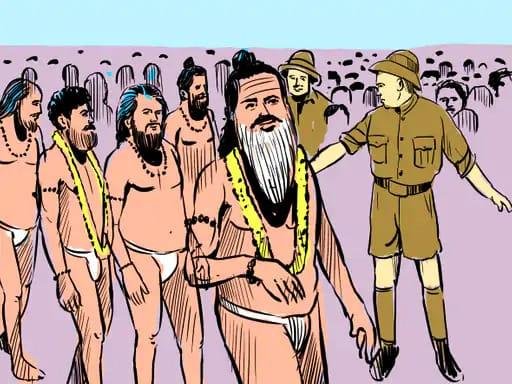
Every person who has developed the feeling of losing himself and merging with the divine can become a sanyasi, which is very difficult. In the fourth episode of this series of Maha Kumbh, know how sanyasis are made from the Sanskrit word nag. Na means mountain and Sanya means people living in mountains or caves. Adi Shankaracharya started the Dashnami sect. Most of the Nagar sanyasis come from this sect. One is Shastradhari, who studies the scriptures; the other is Shastradhari, who is proficient in war. First, Shringeri Math prepared the army of Na village with scriptures. In the beginning, it consisted of Kshatriya laborers. Later the barrier of castes was removed. There are three stages of becoming a Naag. Mahapurush Avdhoot and Digambar are usually given initiation at the age of 17 to 19. The complete renunciation of existence is called being a sanyasi. Before becoming a sanyasi, you are given complete initiation when its practical use is done in life, social life. After extracting the data, who has never committed any crime, then he gets the prey, that the arena hunts him, the Guru hunts him, after this the person has to undergo this test period, here he has to study the scriptures and scriptures, the person who wants to become a saint has to win over sleep, hunger, lust and laziness, after the test period the Guru asks the person to return to the worldly life, even then if he does not return, he is made to take a pledge to become a Sanyasi and here he is declared a great man, after becoming a great man, to become a Naga Sadhu, one has to go through five rites, where five gurus are decided, Shiva Vishnu Shakti Surya and Ganesh with their love sword and the Guru cuts their small slit, that is, it is decided that now you have come under the protection of this Guru, that is, your intelligence will go on the strength of them, the process of making a great man an Avdhoot is also very complex, to become an Avdhoot, one has to fast for three consecutive days and then after that Pinddaan has to be done, a film of the year 16 of his family members and relatives And the 17th is ours and in this way, our life is considered to be over there. According to the Kumbh Mela held at four places, these Naga Sadhus are called differently. The ones who become Naga Sadhus in Prayagraj are called Khooni people in Ujjain, Barfani people in Haridwar and Khichdi people in Nashik. Like male Naga Sadhus, becoming a female Naga Sadhu is also very difficult. They are called Avdhootni or Naagin. In 2013, for the first time, female Naga Sadhus were associated with the country’s oldest Akhara, Juna Akhara. The maximum number of women are in this Akhara. The most senior female Naga Sadhu is called Shri Mahant in the Akhara. Naga Sadhus also calls food items in code words. In the language of Nagaur, the dal in the bus is called Paniara, garlic is called Patal Lok, salt is called Ram Ras and roti is called Roti Ram. In the Haridwar Kumbh of 1760, there was a fight between the people and the Bairagi Sadhus. In the Haridwar Kumbh of 1796, a bloody clash occurred
Stories of Maha Kumbh-5
There was a stampede for Nehru, 1000 people died: and hundreds of bodies were burnt; The photographer arrived in torn clothes and secretly took the picture.
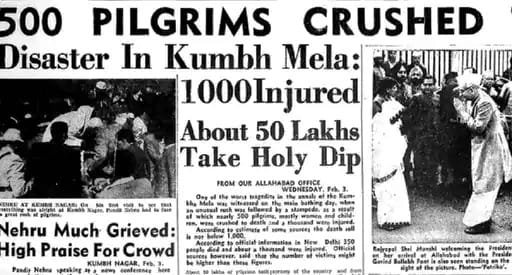
The fifth episode of the Maha Kumbh series tells the story of the first Kumbh after independence and the mayhem that took place in it. In 1954, the first Kumbh of independent India was held in Prayagraj. On February 3, on the day of Mauni Amavasya, in the same way, a crowd of lakhs was gathering for a bath in the Sangam. The then Prime Minister of India Nehru and the President of India, Dr. Rajendra Prasad were coming to the Sangam. They had to go towards the Zila Ghat, so the roads on both sides were blocked. There were also some processions which were stopped there. When Rajendra Prasad ji’s vehicles went towards Kela Ghat, suddenly all the roads were opened and then a train of crowds was seen colliding with each other. The UP government said that no accident occurred in the Kumbh but a photographer secretly took a photo during it. Mukherjee, a photographer at that time, wrote that we felt as if the standing crop was falling. The one who fell could not get up. The one who got up could not run away. The one who ran away fell into a water tank nearby. PM Modi held Jawaharlal Nehru responsible for this. When Pandit Nehru came due to the system, there was a huge crowd here. There was a lot of commotion in the Kumbh Mela. It was India’s first Kumbh. Therefore, the government made many arrangements. A temporary railway station was built near Sangam. For the first time, electric poles were installed in Kumbh and nine permanent hospitals were opened. Gandhian writer B.V. Rajagopal writes in his book Nehru’s Shadow. On the day of Mauni Amavasya, Nehru reached Sangam with his family. Everyone took a dip in Sangam, but Nehru did not even put Ganga water on himself, let alone take a bath. The next day, N. Mukherjee’s photograph of the accident was published.
Stories of Maha Kumbh-6
When people kept wandering all night for shroud: Suddenly the platform of the train changed, 36 died in the stampede; Azam Khan resigned
Similarly, at this very place, 12 years ago, i.e. in 2013, during the Maha Kumbh, thousands of devotees were coming to bathe in the Sangam, while some were waiting for the train to return to their cities, but what happened during this time was not even imagined by anyone. The scene that was seen on the dam changed by the time we reached the railway station. Many people had taken some of them to the railway station. The surprising thing is that just a few hours before this, there was a stampede in the Sangam area and people were killed in that too. The story in the sixth episode of the series of Maha Kumbh in 2013 was in the evening. During the day, crores of devotees were heading towards the railway station to return to their cities after bathing in the Sangam. At Allahabad Junction, there were different lines of passengers coming and going, which come from Sangam and also from Sidhi, which take you to the Line side, you to platform number 6, so this line was not closed, so the crowd was going to this Chowk side instead of some people going on this side and everyone went to the platform. Many trains were running due to which the crowd of people kept increasing. Meanwhile, an announcement was made that trains going to Mumbai or Nagpur would come on the platform. People started running and started falling on each other on the bridge to go in that direction. A total of 36 people were killed in this accident. According to media reports, the railway had a hospital with four beds, but it was locked. People could not be taken to the hospital on time. At that time, Akhilesh Yadav’s government was in power in Uttar Pradesh. Azam Khan was made in charge of the fair. After the incident, Azam Khan resigned. Before the stampede at the railway station, there was a stampede in the area at midnight on the same day. A procession was coming down from the dam. The tractor involved in the procession got unbalanced. People started falling. We also came under its grip and many people got buried under it. Four people were killed in this accident as well. In the next episode of this series of Maha Kumbh, we will learn
Stories of Maha Kumbh-7
Saints rang the tongs and made Modi PM: Indira reached Kumbh as soon as she became the Prime Minister; Sonia’s protocol code was Papa One, Papa Two, Papa Three
It was a period of emergency. On the evening of 18 January 1977, Indira Gandhi gave a speech on All India Radio. I have advised the President to dissolve the current Lok Sabha and order fresh elections. We hope that elections will be held in March. Four days later, Indira Gandhi is going to Kumbh in Prayagraj. This was when people were angry with her due to the emergency. Many saints opposed her in Kumbh too and called her the enemy of the country. During this time, JP also went to Kumbh to meet the saints. When the results came in March, Congress lost the election badly. Indira could not even save her Rae Bareli seat. By winning 295 seats, Janata Party formed the government under the leadership of Morarji Desai. In this episode of the series of Maha Kumbh, the story of politics and Kumbh connection. Indira Gandhi came to Prayag on the very next day after taking oath as the Prime Minister for the first time on 24 January 1966. She became the PM after the death of Prime Minister Lal Bahadur Shastri on 11 January. That year, Kumbh was going on in Prayag. She took oath on 25 January. On 10 June 1989, on the day of Mauni Amavasya, the ashes of Lal Bahadur Shastri were immersed in Sangam. However, Congress did not get any political advantage from Indira’s visit to Kumbh. In the 1967 Lok Sabha elections, the party could win only 283 seats, which was the lowest since 1952. Along with this, the Congress lost elections in states like Punjab, Rajasthan, Delhi, Uttar Pradesh, Bihar, Kerala, Madras, Odisha, and West Bengal. On this very land of Prayagraj, on 1 February 1989, during the Sant Sammelan, the foundation stone of Shri Ram temple was announced. In the book ‘Mera Desh Mera Jeevan’, Lal Krishna Advani writes that the announcement of the Ram temple in Kumbh had a shocking effect on Hindus across the country, but most of the political parties were not publicly supporting the demand of Hindus. As a party, the BJP kept itself away from this issue. In June 1989, the BJP announced the inclusion of Ram temple in its manifesto in the Palampur convention. On 9 November, VHP laid the foundation stone of the temple. Lok Sabha elections were held in the same month. The result was that BJP, which won only two seats in 1984, won. In 1999, Sonia Gandhi won the 85 seats. The issue of Sonia Gandhi being a foreigner was much discussed, after which in 2001 she went to Prayagraj and took a dip in the Sangam. BJP called this a political agent. Three years after she visited Prayag, Lok Sabha elections were held in 2004 and Congress made a comeback. During the 2013 Kumbh, there was a discussion about Narendra Modi becoming the President of Vishwa Hindu Parishad. During this time, the then BJP President Rajnath Singh also came to Prayag for a Sangam bath. It is believed that he had come here to know the opinion of the saints. About three months later, on 9 June 2013, in the BJP National Executive meeting in Goa, Rajnath declared Narendra Modi as the President of the Central Campaign Committee, which made it clear that Modi would take over the reins of BJP in 2014. Tell me, Prime Minister Narendra Modi is in Prayag for the first time during the 2019 Kumbh. During this, he took a dip in the Sangam and honored the sanitation workers by washing their feet. The opposition said that this was inspired by Dalit politics. When the results of the 2019 Lok Sabha elections came, BJP made a comeback. In the next series of Maha Kumbh, which is the next Maha Kumbh? You will know the interesting story of Kalpvas in this episode
Stories of Maha Kumbh-8
Malviya-Nehru clashed with the British for the Kalpvaasis: Women cannot wear makeup; Why do Kalpvasis eat Kadhi while returning
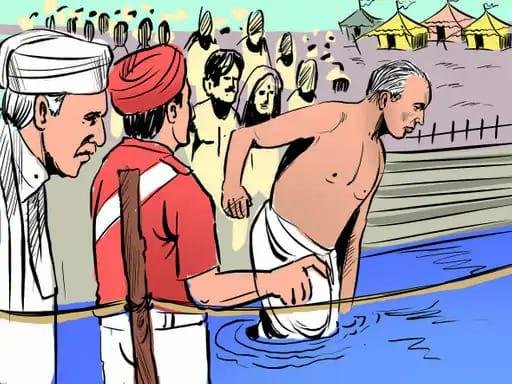
In the Kumbh Mela of 1924, the British government banned this Sangam bath due to a decision against the Kalpvasis because they bathe three times a day, in which an afternoon bath is necessary in Sangam. Pandit Madan Mohan Malviya supported Kalpvasis and started Jal Satyagraha. Later, he also got the support of Jawaharlal Nehru. Despite the opposition of the British government and the police, Malviya took a dip in the Sangam, after which the crowd present there also jumped into the Sangam. In this way, the residents completed the afternoon Sangam bath. In the eighth episode of this series of Maha Kumbh, the story of Kalpvas is told. Kumbh is held at four places including Prayag, Haridwar, Ujjain, and Nashik, but Kalpvas is held only in Prayag. Kalpvas is held from the full moon of Paush month to the full moon of Magh month, staying on the banks of Sangam and studying the Vedas, meditation,g, and practice. The tradition of Kalpvas has been going on for centuries. It is also mentioned in Ramcharitmanas, Mahabharata, and Puranas. According to Vedic literature, 6 Vedantas have been composed for the study of Vedas. These six Vedangas are education. Chhand Grammar Nirukta Astrology and Kal, out of these, the method of Yagya, knowledge, donation, etc. is described in Kap. Kal is made from the word Kap. According to Shankaracharya Swami Mukteshwar Anand, one day of Brahma Ji is called Kap. Kal is a big unit of measuring time. Understand this. There are four yugas in total, Satya Yuga (17,28,000 years), Treta Yuga (12,96,000 years), Dwapar Yuga (8,64,000), and Kalyug (4,32,000 years ). Mahayoga is formed by combining these four yugas. Similarly, one Kal is formed by combining 1000 Mahayugas, which has a total of four billion 32 crore years. That is, if someone does Kalpavas here, then he will get the fruits of one Kal i.e. 32 crore years. According to religious beliefs, a person who passes through this world for 12 continuous years attains salvation. A resolution is taken during rituals or worship, in which the priest Shri Shwet pronounces the word Kalpesh. It means that from the creation of the universe till now 11 Kap have passed and the 12th Kap is going on. When Kalpas comes, first of all, he eats Khichdi. He goes to his tent and plants a Tulsi plant. After the completion of Kalpas, Tulsi is immersed in Ganga. This is an indication that he is entering the world again. In Skanda Purana, Maharishi Dattatreya has given the rules for Kalpas. During Kalpas, speaking the truth for the whole month. Keeping a sense of non-violence towards all living beings. Keeping one’s senses under control. Observing celibacy. Waking up every morning in Brahma Muhurta and taking a bath three times a day, in which one bath in Sangam is necessary. During Kalpas, one has to live a very simple life. During this Kalpas, the Kalpas cannot even go to the house of any of his relatives. In the first Kumbh after independence, President Dr. Rajendra Prasad also took a Kalpas there. In the next episode of the series of Kumbh, we will learn some interesting stories related to Kumbh.
Stories of Maha Kumbh-9
Foreign women started rolling on the sand like naked Nagas: Dip in Sangam wearing a garland of human bones; 8 interesting stories of Kumbh
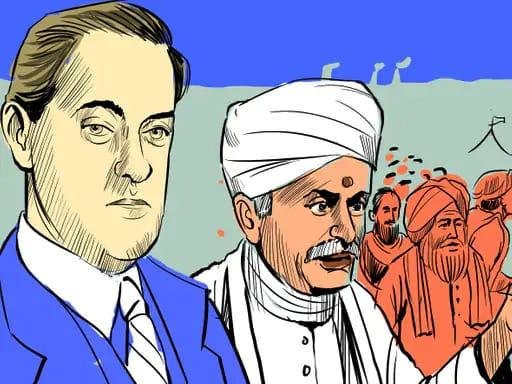
In 1942, exactly 5 years before independence, Kumbh was going on at the banks of Sangam. One day, the Viceroy Governor General of India, Lord Nilesh, was accompanied by Madan Mohan Malviya, who had come to see the Kumbh Mela. The Viceroy was surprised to see the crowd of different people at the Kumbh. He asked Malviya how much money would be spent on publicity to gather so many people at this fair. What did he say? Only two paise. This is possible. Malviya brought out the Panchang and said that it is available for just two paise found in every Indian’s house. People see the date on it and leave the house. There is no need to do any kind of publicity to come here for bathing in the Sangam.In the new episode of this series of Maha Kumbh, some interesting stories related to Kumbh. Professor Dhananjay Chopra of Allahabad University tells an interesting story of the Kumbh held in 2001. I saw that some people and the person walking ahead
Stories of Maha Kumbh-10
Some did not bathe for 32 years, some lay on thorns: Matsyendranath learned Hatha Yoga in the stomach of a fish; Stories of stubborn babas
Someone has not bathed for 32 years, someone has been sleeping on thorns for 35 years, someone is wearing 45 kg Rudraksha, and someone is growing crops on his head, what is this penance, after all, what is this penance, in the last episode of which series of Maha Kumbh, the story of Hatha Yogi and the Hatha Yogis who do it
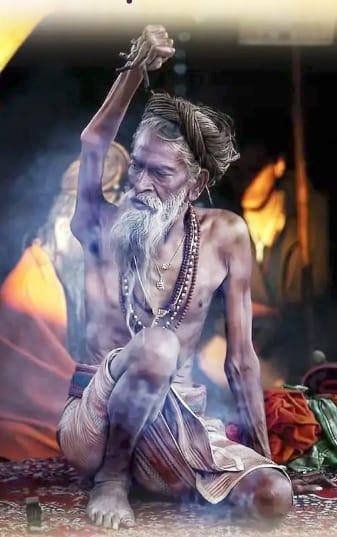
That is why we do not bathe, when we bathe and Kamakhya will go away, without the interference of the senses and the mother, the practice of yoga generally comes under all types of yoga postures, according to Deepika on the most famous and oldest book Hatha Yogi, yes Kar is the symbol of Surya Swar or river, while Thakur is Chandra Swar, Hatha Yogi is made by the combination of Surya and Chandra Swar, Surya Swar is considered to be the symbol of male power and Chandra Swar is the symbol of female power, when we breathe, then both the nostrils i.e. holes do not work together, but it can be made possible by the practice of Hatha Yogi, it is believed that due to the balance between Surya and Chandra river by Hatha Yogi, Susumna river is formed. It awakens which gives spiritual power. Shiva is considered the lord of bones. It is said that the Nath sect started bones. This time in Maha Kumbha also there is a collection of many such Hath Yogas. Earlier Hatha Yogi was limited to only sages and saints. In the 15th century, it became very popular and spread rapidly. By the end of the 18th century, foreigners and Britishers also came to India from every corner of the world to learn it. This way Yoga spread all over the world. Nagapanthi Hatha Yogi Acharya has told Shatkarma i.e. 6 activities to keep the body pure, which include Jyoti for cleaning from mouth to anus, Basti for cleaning the large intestine, Niti for cleaning the breathing path i.e. from nose to lungs, Niti for cleaning the stomach, Nauli for meditation, Natak and Kapalbhati for increasing the brightness of the head. In the books of Hatha Yogi, 6 parts of Hatha Yogi have been told, which include Asana to balance the body and mind, Pranayam to expand the ability to maintain Prana. Pratyahara is included for maintaining concentration, dharna for self-contemplation, and samadhi for freedom from attachment and illusion. Let us now meet Yogo, who is like this. This is the sanyasi Geetanand Maharaj, famous as Rudraksh Baba, who has pledged to wear a Rudraksha on his head for 12 years. Its weight is 45 kg and I was taking a pledge of 1.25 lakh Rudrakshas for the national interest and the benefit of Sanatan Dharma, from Amarjeet Baba, who grows crops on his head on our behalf, may our greenery keep increasing, our tricolor keeps rising, our youth keep fighting, soldiers keep fighting, there is no problem, this is Yogi Ramesh Kumar Baba, famous as Baba, I do penance, it is my duty to do penance, so this was the story of Yoga.
5 crore people took a dip in Maha Kumbh: How the stream coming out of the glacier shaped history, the amazing story of Ganga
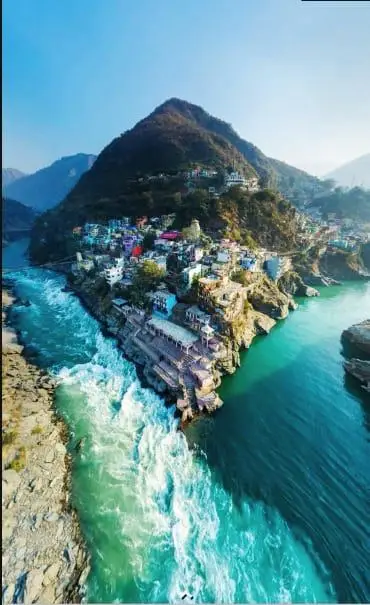
Every 12 years the world’s biggest fair Maha Kumbh is held, crores of people come here not only with faith but also with the hope of salvation and take a dip in the Ganga, what is there in the net of Ganga that people even risk their lives It is believed that 5 crore years ago the Eurasian and Indian plate present under the earth collided which formed the Himalayas, then after 50 lakh years Ganga was born, the stream Alaknanda flows from the Himalayan peak Nanda Devi, while Gangotri is a glacier in the Himalayas itself, from which Bhagirathi flows out of the melting snow, both of them join together in Devprayag to form Ganga, which passes through the Shivalik Mountain Range, Rishikesh, and Haridwar, through Farrukhabad Kanpur of UP, Ganga reaches Prayagraj where it meets Yamuna, after this Ganga moves towards Varanasi and meets the Ghaghra river and reaches Ganga Vihar, here Gandak, Gogri and Kosi Rivers also join the Ganga. West Bengal is the last state of India where the river Ganga enters. This place is also called the beginning of the delta. From here it grows in two streams in India and Bangladesh. In India, meeting Hooghly, the Ganga falls into the Bay of Bengal. The second stream of the Ganga reaches Richya in Bangladesh where it is called the Padma River. Here the Ganga joins the Brahmaputra river. The Ganga, which travels a distance of 2510 km, is the largest river in India. In 2008, the Manmohan government declared the Ganga as the national river. There are some mythological stories related to the coming of the river Ganga to earth. According to the Bal Kand of Maharishi Valmiki Ramayana, there was a king named Sagar in Ayodhyapuri. Pleased with the severe penance of his descendant Bhagirath, Brahma decided to send the Ganga to earth. To handle the speed of the Ganga, Shiva gathered her in his matted hair and then opened a rope due to which the Ganga flowed on the earth and became wind. Now another question is why does everyone want to take a dip in the Ganga? In Hinduism, the Ganga is viewed as a goddess It is believed that bathing in it absolves sins. There is destruction, salvation is attained and the soul gets peace by immersion of ashes. There is an old belief that bathing in Ganga on Ganga Dussehra pleases the gods, so every year on festivals like Ganga Dussehra, Kartik Purnima, and Makar Sankranti, people join together to bathe in Ganga. Ganga River is the lifeline of half the population of the country. According to the World Bank, before 8.6 meters, the Ganga basin is home to 60 crore Indians and 40% of the country’s GDP is produced from here. From time to time, different steps have been taken to clean the Ganga River. In 1985, then Prime Minister Rajiv Gandhi started the Ganga Action Plan for cleaning the Ganga. In 2008, the Manmohan Singh government decided to form the Ganga River Valley Authority to make it pollution-free. In 2014, as soon as Narendra Modi became the Prime Minister, he also included the flagship program Namami Gange with a budget of Rs 20,000 crore for Ganga. Under the mission, 313 projects worth Rs 25,000 crore were approved. According to the 2024 report of the Central Pollution Control Board CPCB, Ganga Pollution is increasing due to 247 drains falling into it. According to the United Nations report, by 2050, due to global warming, the Gangotri glacier will melt, which can dry up the Ganga River. According to Shrimad Devi Bhagwat Katha, after 5000 years of Kalyug, Ganga ji will go back to the Ganges.
Mahakumbh details
The Mahakumbh Mela 2025 will be held in Prayagraj (Allahabad), Uttar Pradesh, at the confluence of the Ganges, Yamuna, and mythical Saraswati rivers (Triveni Sangam)
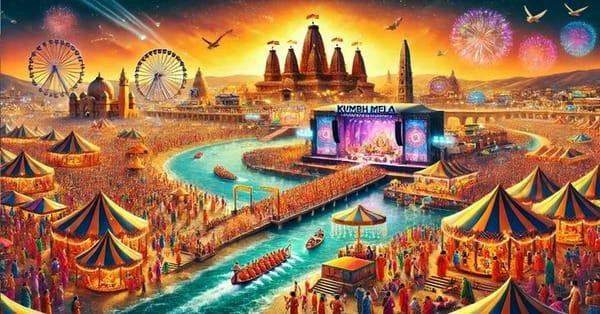
Kumbh Mela. It’s a major Hindu pilgrimage and festival that occurs every 12 years, rotating between four sacred locations: Prayagraj (Allahabad), Haridwar, Nashik, and Ujjain. Each location hosts the Kumbh Mela every 12 years, so the cycle is spread out over 12-year intervals. The last Mahakumbh, which is the “great” Kumbh Mela, was in 2013 in Prayagraj. Then there’s the Ardh Kumbh, which is the “half” Kumbh occurring every 6 years.
Wait, so if the Mahakumbh is every 12 years, then 2013 plus 12 years would be 2025. But where will it be held? Since the rotation is between the four cities, each one gets it every 12 years. The order is Prayagraj, Haridwar, Nashik, Ujjain. Let me check the recent ones. The 2013 Mahakumbh was in Prayagraj. Then the next one in 2015 would have been in Nashik. Wait, no, maybe I’m mixing up the years. Let me think again.
Wait the rotation isn’t strictly every 12 years in order. Let me check the sequence. The four cities are Prayagraj, Haridwar, Nashik-Trimbakeshwar (Nashik), and Ujjain. Each city’s Kumbh Mela is determined by the position of Jupiter in the zodiac. When Jupiter enters Taurus (Vrishabha) and the sun enters Capricorn (Makara), it’s time for Prayagraj. When Jupiter is in Aquarius (Kumbha) and the sun enters Aries (Mesha), it’s Haridwar. For Nashik, Jupiter is in Leo (Simha), and the sun enters Cancer (Karka), for Ujjain, Jupiter is in Scorpio (Vrishchika), and the sun is in Aries.
So based on that astrological positioning, the dates for each Kumbh are determined. The last Mahakumbh in Prayagraj was in 2013. Then the next one would be in Haridwar in 2021, but that was the Kumbh there. Then after Haridwar, Nashik would be next. Wait, but the timing isn’t exactly every 12 years. Let me check the actual dates of previous Kumbh Melas.
Wait, the Mahakumbh in Prayagraj was 2013, then the next Mahakumbh would be 12 years later, so 2025. But which city? Since the cycle is Prayagraj, Haridwar, Nashik, Ujjain. So after Prayagraj 2013, the next Mahakumbh would be in Haridwar in 2025? Wait, no. Let me look up the actual rotation. For example, the previous Kumbh Melas were: in 2001 in Prayagraj, 2013 in Prayagraj again as Mahakumbh. Wait, maybe I’m confusing Ardh Kumbh and Mahakumbh. The Ardh Kumbh is every 6 years. So Prayagraj hosts the Ardh Kumbh every 6 years and the Mahakumbh every 12. Similarly, Haridwar has the Kumbh every 12 years, with the Ardh Kumbh in between. Wait, this is getting confusing. Let me try to structure it.
The four cities host the Kumbh Mela based on astrological positions:
1. Prayagraj (Triveni Sangam): When Jupiter is in Taurus and the Sun is in Capricorn (Makar Sankranti). This happens every 12 years. The last one was in 2013, so the next would be 2025.
2. Haridwar (Ganges): When Jupiter is in Aquarius and the Sun is in Aries. The last Mahakumbh here was in 2021, but due to COVID, it was scaled down. Wait, no, the Haridwar Kumbh was in 2021. Then the next one would be 12 years later in 2033.
3. Nashik (Godavari River): When Jupiter is in Leo. The last one was in 2015, so next in 2027.
4. Ujjain (Shipra River): When Jupiter is in Scorpio. The last was in 2016, next in 2028.
Wait, but this doesn’t align with the 12-year cycle. Maybe each city’s Kumbh occurs every 12 years but staggered so that each one is every 3 years apart. For example, Prayagraj in 2013, Nashik in 2015, Ujjain in 2016, Haridwar in 2021. Hmm, this is getting a bit tangled. Let me check a reliable source.
After some research, I found that the Mahakumbh Mela at Prayagraj occurs every 12 years, with the Ardh Kumbh every 6 years. The 2013 Kumbh was a Mahakumbh, so the next would be 2025. The other cities have their schedules based on planetary positions. So the Mahakumbh 2025 is indeed in Prayagraj. The main bathing dates are determined by specific astrological configurations, usually around Makar Sankranti in January. The exact dates for 2025 would be based on the Hindu calendar, but typically they start in January and go through March or April. The key bathing days (Shahi Snan) are on auspicious days like Makar Sankranti, Mauni Amavasya, Basant Panchami, etc. The expected attendance is tens of millions, with the largest gatherings on the main bathing days. The Uttar Pradesh government handles the logistics, including temporary infrastructure, security, health facilities, and transportation. Environmental concerns like river pollution and waste management are also significant, so there might be initiatives to address those. Pilgrims should plan for crowded conditions, book accommodations early, follow safety guidelines, and respect local customs.
Mahakumbh Mela 2025:
| Category of parts | Details |
|---|---|
| Expected Period | January to March/April 2025 (exact dates based on the Hindu lunar calendar). |
| Main Bathing Dates (Shahi Snan) | – Makar Sankranti – Mauni Amavasya – Basant Panchami – Maha Shivratri |
| Significance | – Largest religious gathering globally (50–100 million pilgrims). – Occurs every 12 years in Prayagraj (last held in 2013). |
| Key Features | – Holy dips at Triveni Sangam. – Prayers, discourses by saints, cultural performances. – Processions by Akharas (ascetic groups). |
| Logistics & Planning | – Temporary tent cities, bridges, sanitation, medical camps. – Enhanced security (police, disaster teams). – Improved transport (trains, buses, flights). – Waste management and Ganges cleanup. |
| Travel Tips | – Book accommodation months in advance. – Stay hydrated, and follow safety protocols. – Dress modestly, and respect local customs. |
| Environmental Initiatives | – Clean Ganga campaigns. – Plastic bans. – Inclusive access for marginalized communities. |
Where do Naga Sadhus go after taking Amrit Snan?: Mysterious world of Nagas with scriptures and weapons, camp outside the country too
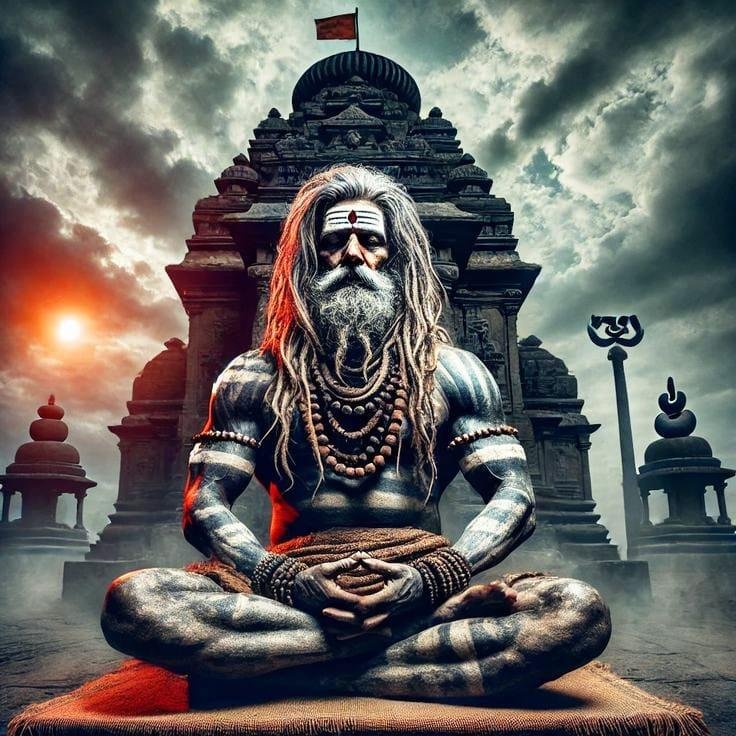
Sanyasi with ashes on the body in Maha Kumbh, playing Damru Dafli at breakfast, these Naga Sadhus have now started going to Kashi after taking Amrit Snan in Maha Kumbh, then from Kashi, they will return to the place from where they came. The life of Naga Sadhus is full of many mysteries, in such a situation it is difficult to know where Naga Sadhus goes. According to Nagar Sanyasi Dada Giri, first of all, Adi Shankaracharya had prepared an army of people in India, Guru Adi Shankaracharya ji created four monasteries, Acharya Shankaracharya ji of all four sects and established them. He prepared a Nagaur to protect Sanatan Dharma while giving initiation to these Sanyasis, 10 names are associated with Giri Puri Indian mountain Sagar Tirtha Ashram and Saraswati, which is why Naga Sadhus are also called Darshanami. Akhara does a complete investigation of the Sanyasi who has come to become a Naga and his family, if he If the person is right to become a sadhu, then only he gets permission. Guru Maharaj, in 12 years, one gets a speech, one dialect, one group, one easy speech. First, the Guru and the disciple have a religious relationship. The word Guru implements what he hears. So, first, you should have a feeling inside you that you did not accept the choice of your soul. When he accepted you in his mind, he accepted him as his Guru. Then after doing all your things, after taking a sanyaas, when you go to the shelter of the Guru, the feeling that you will have inside you is that you will have to serve him for 12 years. People have to meditate and control sleep and hunger throughout the day. They eat only once a day. A Naga Sadhu has the right to take alms from only seven houses. If he does not get any alms from seven houses, he must remain hungry. The village has its language or you can say that they talk in code words. No fake people or imposters can join their arena, so they do this. Naga Sadhus come to Bhasmi Dal, Paniyaram Garlic, Patal Long Onion. Who is called Laddu Ram, Salt is called Ram, Ras is called Lanka Ram, Chilli is called Ghee, and Roti is called Roti Ram. Women become Sadhus without any residence. Juna Akhara is the biggest and oldest Akhara in the country. Most of the women are associated with it. The process of becoming a female Naga is also like that of the male ones. The genitals of the men are deactivated while the women have to take a pledge to follow celibacy. This is a big question seen in Kumbh. Naga monks do not have any fixed place. They live a nomadic life and keep changing the world according to their means.
Maha records made in Maha Kumbh: 65 crore devotees, twice the population of America, took a dip in Sangam, making a world record
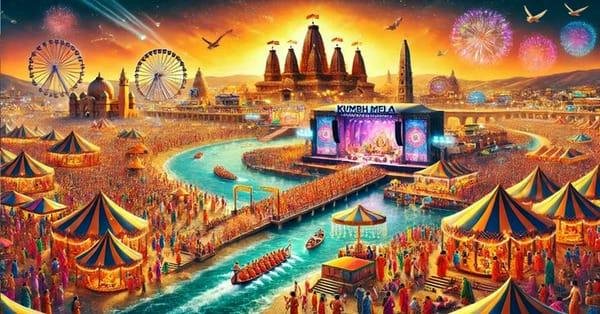
During Maha Kumbh, about 65 crore people took a dip in Prayagraj Sangam. This figure is twice the population of America. Not only this, during the fair which started on 13th January, transactions worth 2 to 3 lakh crore rupees were done, along with this new world records were also made. You will know such interesting records and figures related to Maha Kumbh. Yogi Adityanath of Uttar Pradesh had hoped that 45 crore devotees would participate in Maha Kumbh, but this figure reached about 65 crore. On average, more than 1.5 crore people took a dip in Sangam every day. Nine lakh saints and 10 lakh Kalpavasis were there. Prominent personalities like President Draupadi Murmu, PM Narendra Modi, and the King of Bhutan also took a dip. Not only this, diplomats from 73 countries and 50 lakh foreign citizens also reached Prayagraj. This is the reason that more than 400 VIP protocols have been issued in Maha Kumbh so far. If we look at the infrastructure, the Maha Kumbh area has been given a lot of importance. It was built on 4000 hectares, which is 160 times bigger than the world’s largest stadium, Narendra Modi Stadium. For bathing, 42 ghats were built in 13 kilometers along the Sangam. 30 bridges were built to cross the Ganga and Yamuna. Two highways and 200 new roads were built. Four lakh tents were made for the Kalpvasis. A temporary steel bridge was built at Bela Kachhar with 4500 tons of iron and one and a half lakh toilets were also built. The transportation and traffic arrangements were also tremendous during the Maha Kumbh. 13830 trains brought around 30 crore devotees to Prayagraj. Four and a half lakh devotees participated in the Maha Kumbh through direct trains and flights from 50 cities. More than 600 chartered flights also landed. Around 50,000 jawans were deployed during the Maha Kumbh. This includes jawans from the police, PAC, Home Guard, STF, NSG, CRPF, BSF, and Air Force. Apart from this, 2700 CCTVs and 100 face recognition cameras were installed. 351 fire brigade personnel were deployed. More than 50 fire vehicles, 20 fire stations, and 20 outposts were built. About 700 fire engines along with 38 water policemen were deployed. About 6 lakh people were treated during the Maha Kumbh. A 100-bed central hospital was built here. 20 children were born in the central hospital, while the lives of more than 250 patients were saved in the ICU. About 130,000 people were given free spectacles and 1,500 people donated their eyes. Cleanliness was also taken care of. More than four lakh pictures were put up. One dustbin every 25 meters. More than 11,000 sanitation workers took up the responsibility of cleaning the Maha Kumbh. 800 sanitation teams of 1,212 people were formed, which became the biggest cleanliness drive. It is also estimated that transactions worth Rs. 3 lakh crore have taken place in the fair area. The UP government spent 7:30 crores on the Maha Kumbh. Out of this, Rs. 2,100 crores were given by the central government. Rs. 40,000 crores from the hotel industry. Rs. 20,000 crores from food shops. It is estimated that Rs 20,000 crore will be earned from religious goods and Rs 10,000 crore from transport. Now let’s talk about the four world records made in Maha Kumbh. On February 14, 329 sanitation workers simultaneously created a Girish World Record by cleaning the Ganga and Yamuna rivers. On February 24, 21,000 people simultaneously created a new world record by sweeping. On February 25, a record of more than 500 shuttlecocks was also made and on the same day, a record of hand printing on canvas was also made, which has handprints of more than 10,000 people.
